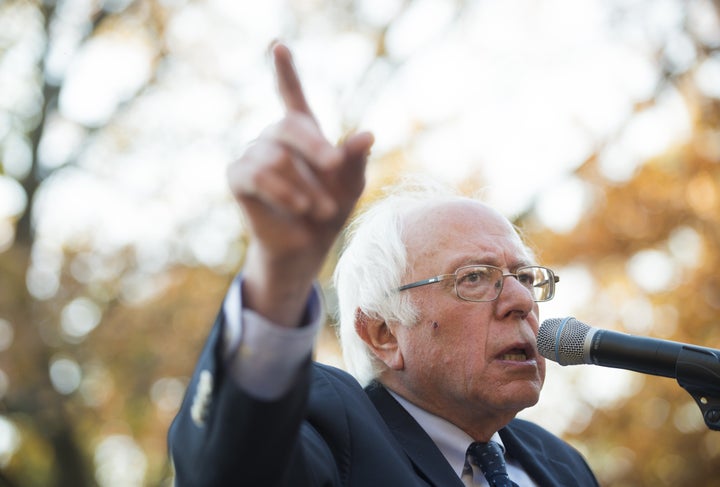
By now, who hasn’t heard a Bernie supporter or surrogate claim that Sanders would have won the election against Donald Trump? The Sanders wing of the Democratic Party has developed a narrative that the Democratic Party was held back by Hillary Clinton. They claim that she was fatally flawed, that the DNC stole the nomination from Sanders, and that the ever so coveted white working class voter dislodged by globalization will never again vote for corporate interests.
Of course, this narrative ignores the facts—that despite Clinton’s supposed flaws, she easily defeated Sanders in the primary via the pledged delegate count, that Sanders inability to convince minority voters doomed his campaign for the nomination, and that the attempt to use superdelegates to override the popular vote was an undemocratic power grab.
And the white workers whose supposed “hate for corporate interests” led them to vote for Trump? They don’t seem upset that Trump has installed three Goldman Sachs executives in his administration. They don’t seem to be angry that Trump’s cabinet is the wealthiest in US history. And we haven’t heard any discontent from the white working class over Trump choosing an Exxon Mobil CEO for Secretary of State.
The devil is in the details, and at first glance, it is easy to see why so many people can believe that Bernie actually would have won. He got a great deal of positive media coverage as the underdog early on, especially with Republicans deliberately eschewing attacks on him in favor of attacks on Clinton. His supporters also trended younger and whiter, demographics that tend to be more visible in the media around election time. A highly energized and vocal minority of Sanders supporters dominated social media, helping him win online polls by huge margins.
But at some point, you have to put away the narrative and actually evaluate performance. This happens in sports all the time, especially with hyped up amateur college prospects before they go pro. Big time college players are often surrounded by an aura, a narrative of sorts, which pushes many casual observers to believe their college skills will translate to success on the next level. But professional teams have to evaluate the performance of these amateur players to determine if they can have success as professionals, regardless what the narrative surrounding them in college was. A college player with a lot of hype isn’t necessarily going to succeed professionally. In fact, some of the most hyped up prospects have the most underwhelming performances at the next level. In the same vein, we can evaluate Sanders’ performance in 2016 and determine whether his platform is ready for the next level. Sanders endorsed a plethora of candidates and initiatives across the country, in coastal states and Rust Belt states. He campaigned for these candidates and initiatives because they represented his platform and his vision for the future of the Democratic Party. In essence, Bernie Sanders was on the 2016 ballot. Let’s take a look at how he performed.
The Performance of Bernie’s 2016 Candidates and Initiatives
Russ Feingold, Wisconsin
Of all of the candidates Sanders lent his support and fundraising arm to, perhaps the most high profile was Russ Feingold, who was seeking to return to the Senate in Wisconsin. Wisconsin is a Midwestern state that is nearly 90 percent white, which makes it a great testing ground for whether the white working class in a Rust Belt state would truly be responsive to Bernie’s message. Feingold championed Bernie’s platform, and his campaign website made bold promises of opposing trade deals, opposing special interests, promoting a $15 federal minimum wage, and advocating for debt-free college.
Feingold ran against incumbent Wisconsin senator Ron Johnson, a more traditional Republican than Trump. Johnson has pushed free trade agreements, infamously saying in 2010 that “protectionism isn’t the answer.” Johnson opposes greater business regulation from the federal government, and the most prominent theme on his campaign website was national security, naming “Islamic terrorism” specifically. Ron Johnson has also been a staunch opponent of immigration, even introducing a bill with Jeff Sessions which would have “ensured the prompt return of unaccompanied illegal immigrant children.”
Ron Johnson combines support of deregulation, free trade agreements (neoliberalism!), and strong national security with an opposition to immigration. In other words, he’s a fairly traditional Republican, in least in comparison to Trump. Since Feingold championed Bernie’s issues, and Bernie endorsed and fundraised for him, he should have easily beaten Johnson, at least if the narrative about Bernie’s strength in the general was true. But Feingold didn’t win. In fact, he lost by a bigger margin than Clinton did in Wisconsin! Clinton lost Wisconsin by a margin of 0.8 percent, while Feingold lost by a margin of 3.4 percent. Feingold was a white man running in a nearly 90 percent white state with the Bernie Sanders agenda. That’s Bernie’s ideal demographic, and his platform still lost to a big business Republican.
Amendment 69, Colorado
In Colorado, a more diverse state than Wisconsin, Bernie’s platform suffered another major setback. Sanders campaigned in Colorado in support of Amendment 69, a measure which would have created a universal healthcare system in Colorado called ColoradoCare. ColoradoCare would cover every single resident of the state of Colorado, and even pay for residents’ healthcare if they had traveled to another state. In order to pay for ColoradoCare, the state would establish a new 10 percent payroll tax, similar to the tax increase which would pay for the Bernie Sanders federal universal healthcare plan. Colorado has a Democratic Governor, a significant Latino population, and is a state that Clinton won by a margin of about 3 percent. If Bernie’s platform is highly popular with the Democratic base, then Amendment 69 should have passed in the state. But it didn’t. Not only did was Amendment 69 rejected, but nearly 80 percent of the voters voted no. Only 21 percent of Colorado voters supported the measure. Again, this is in a blue state, with a key tenant of Bernie’s platform, something that he passionately campaigned for in Boulder. And the voters overwhelmingly said no.
Zephyr Teachout, New York
Zephyr Teachout ran for New York’s 19th Congressional District House seat. Like Feingold, she was endorsed by Sanders and took up many of his positions on the issues. Teachout opposes free trade, opposes lobbyists, and made campaign finance reform a central theme of her campaign. New York’s 19th Congressional District covers Greene, Delaware, Columbia, Otsego, Schoharie, Sullivan, and Ulster counties, in addition to smaller portions of Rensselaer, Montgomery, Broome, and Dutchess counties. These counties are outside the city and lack diversity—most of the counties are over 90 percent white. Most of the counties here are demographically similar to Feingold’s electorate in Wisconsin. With Sanders support, you would think that Teachout would glide into Congress, especially if the white working class was largely favorable to leftist economic populism. Teachout ran against John Faso, a strident supporter of the 2nd Amendment who opposes rising federal spending and derides the additional regulations on Wall Street imposed by Dodd Frank. Surely, Bernie’s platform would appeal to the white working class and push Teachout over the top? Nope—she ended up losing by a margin of 9.4%.
Prop 61, California
In the state of California, Bernie pushed voters to support Prop 61. Prop 61 would have mandated that state agencies pay no more for prescription drugs than the US Department of Veterans Affairs. Sanders went as far as to publish an op-ed in the LA Times saying that a vote for yes on Prop 61 would be “standing up to pharmaceutical greed.” He said that a win in California could “spark a national movement to end the pharmaceutical industry’s price gouging.” Sanders campaigned throughout the state, pushing for the measure. You would think that if Sanders’ platform had any shot, it would do well in California, a state that just elected Democrats to a supermajority in the state legislature and home to some of the most liberal politicians in the country. Clinton won California by a massive 30 percent margin, so at least Bernie got Prop 61 passed right? Wrong—Prop 61 lost 54-46, by an 8 percent margin in a state that Clinton won overwhelmingly.
I could keep going on causes and candidates that Sanders supported—such as Sue Minter for Vermont Governor, or Ted Strickland for Ohio Senate—but I felt that the examples above were prominent and sufficient enough to make my point. In Sanders’ bid to takeover the Democratic Party post-election, he has been very loud talking about his platform and economic populism. But he has been very quiet about how his platform actually performed this election.
Since Sanders Significantly Underperformed Clinton—Can He Really Claim To Be The Future?
There is a lot of debate about the future of the Democratic Party. But there is no debate about whether Clinton or Sanders performed better in 2016. Clinton’s platform clearly outdid Sanders’, even in whiter Rust Belt states supposedly favorable to Bernie’s agenda. This draws out the obvious question—why is the narrative that Bernie’s message is the future, when a host of states spanning the political spectrum clearly rejected it? I could drone on about Bernie’s serious deficiencies with minority voters in the primary (and it is a major problem for the Berniecrats of the future), but key tenants of the Sanders platform, namely universal healthcare and government cost controlled prescription drugs, were beaten badly in blue states.
If Sanders is so clearly the future of the Democratic Party, then why is his platform not resonating in diverse blue states like California and Colorado, where the Democratic base resides? Why are his candidates losing in the Rust Belt, where displaced white factory workers are supposed to be sympathetic to his message on trade? The key implication Sanders backers usually point to is that his agenda is supposed to not only energize the Democratic base, but bring over the white working class, which largely skews Republican. Universal healthcare, free college, a national $15 minimum wage, and government controlled prescription drug costs are supposed to be the policies that bring back a white working class that has gone conservative since Democrats passed Civil Rights. Sanders spent $40 million a month during the primary, and was largely visible during the general, pushing his candidates and his agenda across the country. The results were not good—specifically in regards to the white working class. The white working class did not turnout for Feingold in Wisconsin, or for universal healthcare in Colorado. Instead, they voted against Bernie’s platform, and voted for regular big business Republicans.
Why did Sanders underperform Clinton significantly throughout 2016—first in the primaries, and then with his candidates and initiatives in the general? If Sanders’ platform and candidates had lost, but performed better than Clinton, than that would be an indicator that perhaps he was on to something. If they had actually won, then he could really claim to have momentum. But instead, we saw the opposite result: Sanders’ platform lost, and lost by much bigger margins than Clinton did. It even lost in states Clinton won big. What does that tell us about the future of the Democratic Party? Well, perhaps we need to acknowledge that the Bernie Sanders’ platform just isn’t as popular as it’s made out to be.
